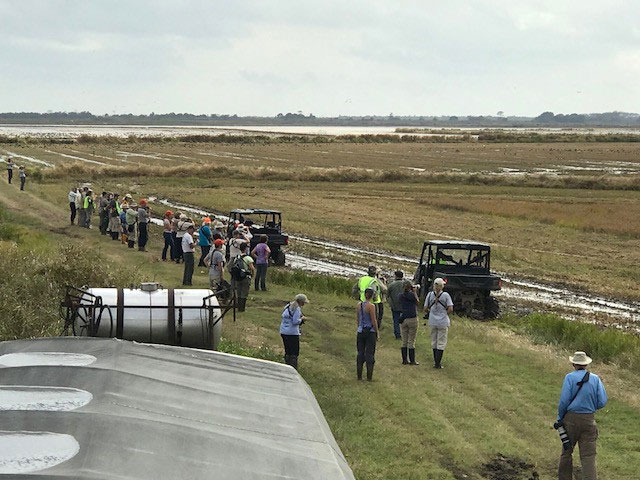 Waiting out the rains
Waiting out the rains
Nov 06, 2017
THORNWELL, LA -- Every year around early November, birders, researchers, and wildlife conservationists from around the world converge on rice fields near here to witness the migration of a very special bird: the yellow rail.
A small, inconspicuous marsh bird, the yellow rail is at the top of bird-watching lists due to its shy nature. It lives in the underbrush of marshy fields, feeding on insects, snails, and vegetation. It is so elusive that even scientists at the Louisiana State University Museum of Natural Science, who know the species better than anyone, aren’t sure where it winters. Ornithologists believe the yellow rail spends the cold months somewhere further south, in the brackish salt marshes of coastal Texas.
Rice farmer Kevin Berken can tell you where they spend Halloween, though: his rice fields.
Thornwell is known as the Yellow Rail Capitol of the World and for good reason. Rice fields like Berken’s are an essential pit stop for migratory birds, and yellow rails in particular seem to love the straw leftover between the first and second harvests.
Berken founded the Yellow Rails and Rice Festival nine years ago so that bird enthusiasts could check this rare species off their lists, and in the meantime learn about how rice fields provide invaluable habitat to many coastal animals. For species threatened by coastal erosion and urban development, southwest Louisiana rice fields are a sanctuary.
“For things like the yellow rail, they’re critical,” says Michael Seymour, avian biologist for the Louisiana Department of Wildlife and Fisheries. “The brushy borders of rice fields and all those fence rows are very important for migratory birds.”
According to Seymour, wildlife conservationists are especially worried about rice fields being replaced with other crops. “I think the rice fields do a whole lot for these birds.”
The festival kicks off with Berken conducting an orientation session or “Rice Farming 101” for the birders. He explains not just what they’ll directly see in the fields, but things they might not see – like his conservation practices. He also explains the rice industry – the varieties grown in the six major rice producing states – and the challenges the industry faces – specifically from imported rice.
But the real fun gets underway when Berken takes bird-watchers out on his combine, the rails take flight or scurry into a net, where wildlife experts give a hands-on demonstration of how to band the rail’s leg.
This year 120 participants, representing 30 U.S. states and four countries, attended. “No one has left one of our festivals without seeing a yellow rail, but this year was a challenge,” said Berken. That’s because it poured rain intermittently all day on Wednesday, the festival’s first day, and according to Berken, these birds “don’t like wet feet.” Yellow rails are almost impossible to spot in the rain because farmers need better conditions to run the equipment that flushes the birds out.
Festival attendees didn’t seem worried, however. The sun was out on Thursday, and by that afternoon, everyone had seen a yellow rail taking flight from Berken’s rice field. Festival attendees then moved on to Myers Landing for a jambalaya supper, with music provided by a local Cajun band. Friday and Saturday continued with improving, dryer weather conditions and tours of various bird habitat regions including Kisatchie National Forest and the Cameron Coast, and more yellow rail spotting from the combines in Thornwell.
Berken is widely praised for his efforts with the festival that shows another side of farming and creates allies in the naturalist community.
“A lot of people have a negative view of production agriculture, but the beauty of this kind of event is that when they come out here and see farmers taking care of the land, producing high quality food in a sustainable fashion, conserving water and reducing inputs, and then they get to see the wildlife – yellow rails actually utilizing the fields – it provides a better connection to how production agriculture is contributing to the overall health of the environment,” said Kevin Norton, state conservationist for the United States Department of Agriculture Natural Resources Conservation Service (USDA RCS) in Louisiana.
Or as Berken said to the throngs of birders gathered at his farm: “Rice farms provide more wildlife habitat than any other crop. Save a bird - buy rice.”